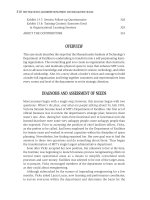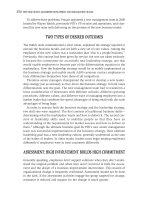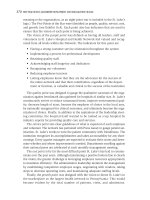Tài liệu Best Practives in Leadership Development & Organization Change 21 ppt
Bạn đang xem bản rút gọn của tài liệu. Xem và tải ngay bản đầy đủ của tài liệu tại đây (153.73 KB, 10 trang )
reinforces the point that leaders can demonstrate excellence when they have to
but also need to pay attention to what they do during normal times, when they
tend to fall back into old habits.
Lesson Six: Pick your instruments carefully and be sure to have enough data
points to support change. Surveys need to closely align with the overall construct
of the program. In this case the three surveys and peak performance analysis rein-
forced the three levels of leaderships both from the moral foundation perspective
and from the individual, team, and organizational perspective. Also, be sure the
instruments can correlate so they reinforce what leaders may need to work on,
and don’t allow leaders to walk away from the real issues.
Day two closes with Marshall Goldsmith’s coaching model that we have
adapted (Goldsmith, 2001). At this point participants have enough data to
select one item that they want to work on, and we apply Marshall’s coach-
ing model so that they can get ideas about how they can improve from their
colleagues. This is a great end to the experiential part of the day because the
participants learn that they all have similar issues that they are working on
and that they can get very practical suggestions from each other for how they
can improve. Marshall’s model is very user friendly and easy to implement
with busy executives. There is an added benefit, as this sets the tone for peer
coaching that will go on for the rest of the week. Participants not only
get individual one-on-one coaching but also an environment is created in
which they are coaching and helping each other improve. These relation-
ships have lasted well beyond the program; teams often follow up with each
and have “improvement calls” with each other. In addition, many have used
this model with their own staff to build more teamwork when they return to
work.
Days three and four focus on the leader-follower relationships and learning
an Organization Analysis (OA) model—a systems thinking model for organiza-
tions that helps drive strategy. The OA model is a tool used to analyze a business
case specifically selected for the program that is typically around a new change
initiative or a contemporary problem that needs to be addressed. The case is not
a Harvard Case Study but rather a statement of facts written relative to the Orga-
nization Analysis (OA) model—a type of organizational 360. The model builds
on Six Sigma and enables a business leader or leadership team to diagnosis a
business situation and determine the areas they will need to work on to improve
the organization. (See Chapter Seven for more information about the Six Sigma
program.)
Participants are also put into intact teams to work on the case. They contract
with each other around the team behaviors and process to be used, and the
coach plays the role of process observer and team feedback provider. The coach
is empowered to point out when dysfunctional behavior or process is occurring,
thus enabling the team to learn and self-correct. Team behaviors tend to come
170
BEST PRACTICES IN LEADERSHIP DEVELOPMENT AND ORGANIZATION CHANGE
cart_14399_ch06.qxd 10/19/04 12:17 PM Page 170
out strongly because the teams are given a real business case to work on. This
provides another significant level of learning by doing.
Organization Analysis Model
The case is typically twenty-five to thirty pages long and presents facts on each
aspect of the OA model. It provides sufficient data for a team to make reasoned
judgments about the issues. In addition, the business owner of the case attends
the program and answers any questions that the teams may have about the
case. Associated with the OA are a series of questions that assist the teams in
determining the component of the model they will have to attack first if they
are to drive sustainable improvements. Their recommendations are reported on
the final day of the program to the business owner and to someone from the
office of the CEO. The teams learn the model and apply it to a real issue. This
approach helps them conceptualize how to drive change relative to a serious
business concern that can be applied to their own organization.
Lesson Seven: Driving team behavior and learning change is most effective
around a real, pressing business issue. This is not a game or group exercise but
something that is important to the success of the company. Also, team behaviors
tend to come out in a more pronounced way when people are working on issues
they really care about. The lessons of how they affect others and potentially affect
followers are even more poignant. They can take a look at their values and see
how their behavior in action is or is not consistent with the values that they
profess—another very significant learning point. They get a bird’s eye view of
the impact they have on their followers.
GE CAPITAL
171
Business strategy
and planning
Human resource
development and
management
Process
design and
management
Customer
focus
Enabler
Goal
Management
system
Information
and analysis
Customer and
employee satisfaction
Leadership
Financial and market
Human resources
Supplier
Performance results
Operational
Figure 6.3 Organizational Culture.
cart_14399_ch06.qxd 10/19/04 12:17 PM Page 171
The program ends on day five with pulling all the experiences together into a
cohesive whole. Participants finalize their personal development plans and their
group recommendations on the business issue, and do one last round of team
coaching to determine what could they have done better as a team and as indi-
vidual team players. They also define their leadership lessons learned. The pro-
gram concludes with a report and dialogue conducted with typically the president
or CEO or someone very senior from the office of the CEO. The concluding reports
are significant in that they lay the groundwork for what recommendations will be
adopted by the organization going forward. For the record, many of the sugges-
tions have gone on to be implemented within the company with great success. A
week at a glance is provided so the readers can get a flavor of the actual flow of
the program (Exhibit 6.4).
FOLLOW-UP AND RESULTS
Even though the formal program ends, there is considerable follow-up that takes
place. Participants are surveyed for actions they have taken at the individual,
team, and organizational levels to drive change—following the original construct
of the program around the three levels of leadership. By all accounts significant
improvements have been noted. Also, participants are queried relative to addi-
tional support they might need in order to continue to grow as leaders. These
data are used as the basis for one-day follow-up sessions around specific lead-
ership issues. These “Best Practice” forums are events for which we bring in
experts on specific key topics. Marshall Goldsmith did an intensive session on
coaching, and Jay Conger did an in-depth session on strategic communication, to
name just two. This keeps the learning going.
Three months and six months after the initial program we also conduct a
mini-360 around each person’s specific development need. We have found that
in 95 percent of the situations participants have improved on the job as viewed
by their original feedback givers. This is a very important statistic. We know for
a fact that the program has significant impact because the business has been
changed as a result of the participants’ recommendations, and participants
themselves have noted significant personal change, but most important the
people they deal with have seen sustained change. We think the results speak
for themselves.
Of course we do program evaluations to make sure that the design and con-
tent remain relevant and adapt to a global audience. The program consistently
gets a 4 out of 4 rating, indicating that we have perfected an approach that is
repeatable and reliable no matter where it is conducted. The real proof of
success, though, is in the quantifiable results that come from the effort.
172
BEST PRACTICES IN LEADERSHIP DEVELOPMENT AND ORGANIZATION CHANGE
cart_14399_ch06.qxd 10/19/04 12:17 PM Page 172
Lesson Eight: Follow-up is absolutely key to demonstrating improvement and
change. An intervention without follow-up is just another intervention that
cannot document real business impact beyond the smile sheets.
FINAL OBSERVATIONS
Constructing powerful leadership interventions with lasting impact requires a
lot of planning up front. Of particular importance is a thorough understanding
of the business challenges going forward. This provides the context for leader-
ship development that is essential. Leadership development is not about skill
building; it is about getting in touch with your values and principles and acting
in ways that are consistent with those values and principles.
In constructing global leadership development, understand that organization
culture and leadership values are different from country cultures and values
(Hofestede, 1997). At the leadership and organization level, we discovered that
there was remarkable consistency relative to the organization cultures and per-
sonal values that leaders and their teams felt were optimum for excellent busi-
ness performance. The data collected from around the world support this
assertion.
GE CAPITAL
173
cart_14399_ch06.qxd 10/19/04 12:17 PM Page 173
174
BEST PRACTICES IN LEADERSHIP DEVELOPMENT AND ORGANIZATION CHANGE
Exhibit 6.1. Executive Leadership Development Symposium: Personal Challenges
Reflect upon the following questions about your personal leadership challenges
and bring your written responses to the Symposium.
What has been your greatest leadership challenge?
1. What was the situation?
2. What made it a challenge?
3. How did you handle the situation?
4. What did you learn?
cart_14399_ch06.qxd 10/19/04 12:17 PM Page 174
GE CAPITAL
175
Exhibit 6.2. Executive Leadership Development Symposium: Organizational Challenges
1. What do you see as the biggest strategic challenge facing the company in the
next two or three years?
2. What leadership skills and capabilities do you consider to be key development
priorities for me in order to meet these challenges?
cart_14399_ch06.qxd 10/19/04 12:17 PM Page 175
176
BEST PRACTICES IN LEADERSHIP DEVELOPMENT AND ORGANIZATION CHANGE
Exhibit 6.3. Executive Leadership Development Symposium: Additional Personal Challenges
Reflect upon the following questions about your personal leadership challenges
and bring your written responses to the symposium.
When you look at your career, what do you see as the critical decision points?
How do you feel about the choices you’ve made over the years?
What were your critical success factors?
Describe a time when you were at your best as a leader.
1. What was the situation?
2. What were you doing that made this a defining moment?
3. What do you value most from this experience?
4. What characteristics of effective leadership did you demonstrate?
cart_14399_ch06.qxd 10/19/04 12:17 PM Page 176
Exhibit 6.4. Sample Agenda: ELDS Program at a Glance
9:30–10:30
A
.
M
.
Opening & Framework
for the Program
10:30–12:15
P
.
M
.
Foundation of Leadership
8:30–8:45
A
.
M
.
Morning Pulse Check
8:45–10:15
A
.
M
.
The Challenges of
Leading a New
Business
10:30–12:00
P
.
M
.
Leadership Behavior &
Organizational
Performance: A Cause
& Effect Relationship
7:30–8:30
A
.
M
.
Coaching Breakfasts
8:30–8:45
A
.
M
.
Morning Pulse Check
8:45–9:45
A
.
M
.
Introduction to the OA
Model and Individual
Analysis of GEC
9:45–12:15
P
.
M
.
Initial Team Discussion
of Analysis of GEC
7:30–8:30
A
.
M
.
Coaching Breakfasts
8:30–8:45
A
.
M
.
Morning Pulse Check
8:45–10:00
A
.
M
.
Q&A with Business
Case Owner
10:15–12:00
P
.
M
.
Team Meetings: Analy-
sis of Case
7:30–8:30
A
.
M
.
Coaching Breakfasts
8:30–8:45
A
.
M
.
Morning Pulse Check
8:45–9:45
A
.
M
.
Challenge Rounds:
Organizing for Final
Recommendations
9:45–12:00
P
.
M
.
Prepare for Final Report:
— Business Case
— GE Capital
— Leadership Lessons
Learned
Monday, Tuesday, Wednesday
, Thursday, Friday
,
September 30
October 1
October 2
October 3
October 4
Morning
(Continued
)
cart_14399_ch06.qxd 10/19/04 12:17 PM Page 177
12:30–4:30
P
.
M
.
12:00–1:45
P
.
M
. 12:30–2:00
P
.
M
.
12:15–2:00
P
.
M
.
12:00–1:30
P
.
M
.
Building the GE
First Impressions
Leadership Leadership Discussion:
Final Team
Brand in Europe
Exercise
Challenges
Driving Growth
Feedback
Exhibit 6.4. Sample Agenda: ELDS Program at a Glance (
Continued)
2:15–4:30
P
.
M
.
Discussion: Business
Challenges & Leader of
the Future Requirements
4:30–5:30
P
.
M
.
360° Feedback
Introduction of Executive
Coaches
6:00–7:30
P
.
M
.
Fireside Chat: Building a
Career in GE & the
Leader’s Responsibility in
Attracting and Retaining
the Best
7:30
P
.
M
.
Dinner
2:00–4:00
P
.
M
.
MBTI—Leadership &
Team Performance &
Decision Making
4:15–6:00
P
.
M
.
Luxor Case &
Behavioral Coaching
Model/Action Plans
Started
6:30–8:00
P
.
M
.
Dinner, Coach Meetings
9:00–10:00
P
.
M
.
Coaching Meetings
2:15–3:00
P
.
M
.
Prepare for Report on
GEC
3:00–3:45
P
.
M
.
Reports
4:00–5:00
P
.
M
.
Team Huddle to
Discuss Business
Case/Questions
Determined to Ask
Case Owner
5:00–6:00
P
.
M
.
Coaching Meetings
6:00–9:00
P
.
M
.
Offsite Dinner on
Pescatori Island,
Fireside Chat
2:00–5:30
P
.
M
.
Business Case (cont.)
5:30–6:30
P
.
M
.
Coaching Meetings
6:30–8:00
P
.
M
.
Fireside Chat: The
Leader’s Role in
Driving Six Sigma
8:00
P
.
M
.
Dinner/Coaching
Meetings
9:00–10:00
P
.
M
.
Coaching Meetings
1:30–2:00
P
.
M
.
Rehearsal
2:15–4:00
P
.
M
.
Report & Dialogue
4:00–4:30
P
.
M
.
Group Photo and
Program Evaluation
Monday, Tuesday, W
ednesday, Thursday, Friday
,
September 30
October 1
October 2
October 3
October 4
Lunch
Afternoon
Evening
cart_14399_ch06.qxd 10/19/04 12:17 PM Page 178
Last, but perhaps most important, involve your business leaders directly in
your effort. Make them your partner in the design, delivery, and follow-up. This
is how you all win in the end.
REFERENCES
Andersen Consulting. (1999). The Evolving Role of Executive Leadership. Wellesley,
Mass.: Andersen Consulting Institute for Strategic Change.
Argyris, C. (1976). Increasing Leadership Effectiveness. New York: Wiley.
Bass, B. M. (1990). Bass and Stoghill’s Handbook of Leadership: A Survey of Theory
and Research. New York: Free Press.
Clark, K. E., Clark, M. B., and Campbell, D. P. (1992). Impact of Leadership.
Greensboro, N.C.: Center for Creative Leadership.
Clawson, J. (1999). Level Three Leadership. Upper Saddle River, N.J.: Prentice Hall.
Conger, J. A. (1993). “The Brave New World of Leadership Training.” Organizational
Dynamics, 21 (3), 46–58.
Cooperrider, D. L. (1997–1998). “Appreciative Inquiry.” (Class lecture: Benedictine
University Ph.D. program, Lisle, Ill.)
Deal, T. E., and Kennedy, A. A. (1982). Corporate Cultures: The Rites and Rituals of
Corporate Life. Reading, Mass.: Addison Wesley.
Finkelstein, S., and Hambrick, D. C. (1996). Strategic Leadership: Top Executives and
Their Effects on Organizations. St. Paul, Minn.: West.
Goldsmith, M. (2001). “Helping Successful People Get Even Better.” Leading for
Innovation. San Francisco: Jossey-Bass.
Hofestede, G. (1997). Cultures and Organizations. New York: McGraw Hill.
Senge, P. M. (1990). The Fifth Discipline: The Art and Practice of the Learning
Organization. New York: Doubleday.
Tichy, N., and Cohen, E. (1997). Leadership Engine. San Francisco: Jossey-Bass.
ABOUT THE CONTRIBUTOR
Linda Sharkey is currently vice president of organization development and
staffing (O&S) for GE Commercial Equipment Finance (CEF), a billion-dollar net
income business, part of GE Commercial Finance. In this role Linda is respon-
sible for the identification, development, and succession planning of CEF’s
leadership talent and leads the Session C and performance management
processes. She also spearheads CEF’s strategic staffing initiatives and works
closely with the leadership team on organizational design, restructuring, and
acquisition integration. Linda joined CEF from GE Equity, where she served as
senior vice president of human resources. Previously, she held the position of
GE CAPITAL
179
cart_14399_ch06.qxd 10/19/04 12:17 PM Page 179









